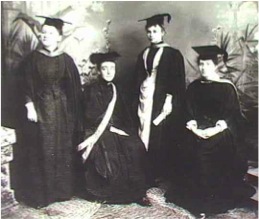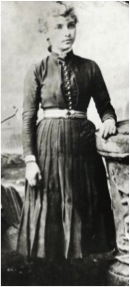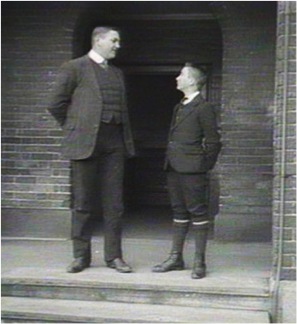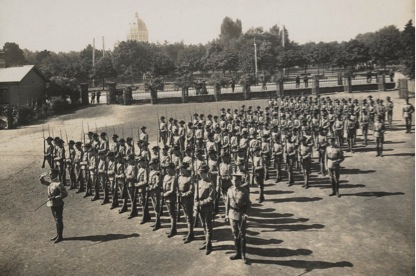This form of post-elementary schooling was introduced from the nineteenth century in the Australian colonies and then states. Cities and towns in the United States and Scotland began introducing public high schools from earlier in the nineteenth century, but the Australian colonies held to the English tradition that church and private grammar schools and academies (see glossary) would be the main providers of post-elementary education through most of the nineteenth century.
The first public high schools in the nineteenth century
The first public high schools required students to pay fees unless they were scholarship holders. They were academically selective and single sex in character. The Advanced School for Girls was the first (South Australia, 1879-1908), soon followed by eight New South Wales high schools authorised by the 1880 Public Instruction Act. These schools were Sydney Boys and Girls (1883- ), Bathurst Boys (1883-1887), Bathurst Girls (1883-1898), Maitland Boys and Girls (1884-1986), and Goulburn Boys and Girls (1883-1886).

Figure 1: University of Adelaide graduates 1900, old scholars of the first Australian public high school, the Advanced School for Girls. State Library of South Australia, B25677/13
There had been other government founded mainly secondary schools before then. Separate acts of the colonial parliaments established Sydney Grammar School (1854), several grammar schools in Queensland (1863-1892) and the Perth High School in Western Australia (1878). None of these schools were part of bureaucratically organised state systems of education. They were not part of emergent systems of government education such as early National, and then later public elementary and primary schools. These nineteenth century government-founded grammar schools were usually governed by independent trusts or councils, though they were funded to some degree by government grants. During the twentieth century such schools were grouped with the church corporate schools, in the non-government sector, rather than the Education Department controlled public high schools.
Reasons for public high school foundations
The reasons for the foundation of education department controlled high schools were many. When the colonies established public school systems, usually in the 1870s, many of their promoters recognised that families whose students completed public school would seek publicly provided opportunities to further their education. The acts of parliament that provided such systems in New South Wales and South Australia for example, provided for such upward extension. Early attempts to do similar in Victoria were successfully opposed by forces led by private and church corporate school proprietors and principals (see Hooper in Campbell et al., 1999).

Figure 2: Ethel Turner, future novelist, 15 year old student at Sydney Girls High in 1885. National Library of Australia, nla.pic-an10998777-332
At the same time there were other pressures towards the public high school arising from industrial, trade, agricultural and other economic forces. The demands towards the end of the nineteenth century for better educated workers, technicians, scientists, businessmen and managers were a legion. Much of this commentary was tied to arguments about the future of the British Empire, not simply individual colonies. Economic competition from Prussia, then Germany, and the United States appeared to require a second-stage industrial revolution and stronger economic growth and efficiency, and such development would be dependent on better and higher education opportunities routinely made available to more of the population.
By the end of the nineteenth century there were other social pressures that made public high schools appear desirable. The discovery of the adolescent, who required better protection from too-early an entry into the labour market and the temptations of adult life, assisted the idea that compulsory schooling should be extended beyond the usual end-point, the thirteenth birthday. Prolonged schooling, it was often argued, would solve the larrikin problem: too many youth, mainly boys but sometimes girls, encouraged into criminal, profligate and sexually precocious behaviours. Both Frank Tate and Alfred Williams, respectively Directors of Education in Victoria and South Australia in the early twentieth century, made this argument.
Preparedness for the commonly expected coming European war also provided reasons. Not only would scientific, managerial and technical expertise be required to help win it, but parts of the Empire, including the Australian colonies, had hardly recovered from the shock of how unfit had been recruits from the cities for colonial armed contingents in the Boer War (1899-1902). Prolonged schooling would assist training young people for military necessity. In the new Australian federation, Defence Act amendments in 1910 mandated the training of boys for this purpose.
There was also an argument that arose from the demands of democracy. Labor parties in the colonies, founded from the early 1890s, often demanded that equal opportunities for higher education be made available for working, as well as middle class children. These demands sometimes conceived higher education for the working class as technical education, but not always.
The fragility of the earliest high schools
There were several ways in which the demand for post-elementary education could be met. In New South Wales junior secondary classes were added to the programs of selected public elementary schools, and the consequent Superior Public Schools were highly effective from 1881. In fact they inhibited the development of the public high schools founded in New South Wales just two years later, from 1883. Superior public school fees were much lower than those of the high schools. In New South Wales the newly founded high schools in Goulburn and Bathurst did not survive the nineteenth century in the face of small enrolments and the hostility of nearby private and church corporate schools (Dunlop, 1965).
The very few Australian public high schools founded in the late nineteenth century were experimental in many respects. If their formal reason for existence was to provide access to higher education based on the merit (examination passing ability) of their students, their social reality was somewhat different. In this period post-elementary education was usually conceived as ‘middle class education’, and the public high school was seen potentially as a school that could deliver similar curricular and social opportunities as the better class of private and church corporate schools.
The public high school foundations of the early twentieth century
A second wave of high school foundations occurred prior to and during the Great War (1914-1918). They are associated with the reform agendas of royal commissions such as Knibbs and Turner (NSW) and Fink (Victoria), and reports of public officials travelling abroad. They are also associated with a new group of New Education influenced directors of education including Peter Board (NSW), Frank Tate (Victoria), Alfred Williams (SA), Cecil Andrews (WA), William Neale and W. T. McCoy (Tasmania) and Reginald Roe (Queensland).

Figure 3: Melbourne Continuation School in Spring Street, Melbourne, Victoria’s first public high school. (State Library of Victoria, H41844)
Some institutions that had been doing the work equivalent to high schools became high schools. The Melbourne teacher training college, and in Adelaide a similar institution, the pupil teacher school had educated potential primary school teachers beyond the elementary curriculum. They became Melbourne Continuation and then High School (1905- ) and Adelaide Continuation and then High School (1908- ). The latter incorporated the Advanced School for Girls as well as the ‘top’ of a virtual superior public school, the ‘continuation classes’ of the Grote Street Public School.
In New South Wales, this pattern had been pioneered by the various manifestations of the old Fort Street National/Public School from 1850. Fort Street Boys and Girls High schools emerged from this complex teacher preparation and superior education history in 1911.
The following list of schools is made up of those Australian public high schools that were founded in this second wave, between 1901 and the Great War. Because public high schools were in the process of being ‘invented’ there may be inconsistencies in what is recorded as a ‘public high school’ in one state as opposed to another.
One of the features of this list is the prominence of schools in country districts. Access to post-elementary schools, private and church corporate, was seen as more readily available in the cities. The great demand was for more opportunities outside the cities. The location of high schools also reflected the fierceness of the opposition to government high schools in cities, especially in Melbourne. Country districts still had substantial political influence early in the century. Also to be noted in the list are high schools named for the demands of the age, especially better agricultural education. In Victoria the argument for many early high schools was only won on the grounds that they would be ‘agricultural’ high schools. A combination of Frank Tate’s desire to see the ‘general’ academic course established, and the common desire of parents for an education for their children much the same, but cheaper, than that available in the better private and church corporate schools, usually saw an agricultural focus difficult to establish. In Queensland no public high school was founded in the same district where a state-founded grammar school already existed. This caused problems of access into the future for Queensland families.
Australian public high schools founded from 1905 to 1914
- Melbourne Continuation/High (Victoria, 1905)
- Newcastle High (NSW, 1906)
- Hurlstone Agricultural High (NSW, 1907)
- Sale Agricultural High (Victoria, 1907)
- Warrnambool Agricultural High (Victoria, 1907)
- Adelaide Continuation/High (SA, 1908)
- Sydney Technical High (NSW, 1909)
- Shepparton Agricultural High (Victoria, 1909)
- Wangaratta Agricultural High (Victoria, 1909)
- Ballarat Continuation/Agricultural High (Victoria, 1910)
- Fort Street Boys High (NSW, 1911)
- Fort Street Girls High (NSW, 1911)
- Colac Agricultural High (Victoria, 1911)
- Mansfield Agricultural High (Victoria, 1911)
- Warragul Agricultural High (Victoria, 1911)
- Perth Modern (WA, 1911)
- Grafton High (NSW, 1912)
- Orange High (NSW, 1912)
- Wagga Wagga High (NSW, 1912)
- University High (Victoria, 1912)
- Bendigo High (Victoria, 1912)
- Leongatha Agricultural High (Victoria, 1912)
- Warwick State High (Quensland, 1912)
- Bundaberg State High (Queensland, 1913)
- Charters Towers State High (Queensland, 1914)
- Gympie State High (Queensland, 1912)
- Mackay State High (Queensland, 1912)
- Mount Morgan State High (Queensland, 1912)
- Bathurst High (NSW, 1913)
- Goulburn High (NSW, 1913)
- Parramatta High (NSW, 1913)
- Hobart High (Tasmania, 1913)
- Launceston High (Tasmania, 1913)
- North Sydney Girls High (NSW, 1914)
- Goldfields High (WA, 1914)
This list leaves out many schools that were variously named ‘district high schools’ or ‘central schools’. They generally followed the superior public model, though in South Australia for example, in 1915, there was a conversion of the ‘district’ high schools founded in 1909 and 1910 into full high schools that necessarily involved their complete separation as tops from the public (mainly primary) schools. In Adelaide these included Norwood and Unley High schools, and a new foundation, Woodville High.
In this period there was continuing confusion about the forms of secondary schooling being invented. Frank Tate gave evidence to a royal commission on education in South Australia in 1911:
Commissioner: What do you imply by the terms ‘intermediate’ and ‘secondary’?
Tate: It is very difficult to say. I think the term ‘secondary education’ has usually been applied to a preparation for future professional training in the University. There has been no name given to the kind of training between the elementary school and the technical school. … we have kept the term ‘higher elementary’ … and we are trying to popularise the use of the term ‘intermediate education’ … that would be a short secondary course … it would not be a grammar school course. (Quoted in Campbell, Campbell et al., 1999, p. 4.)
Tate went on to confuse the commission further by attempting to mark the differences between a ‘secondary school’ and a ‘high school’.
Unlike New South Wales in the 1880s, the early twentieth century public high schools usually survived and often flourished. In the process, in country and city areas, small private schools found the competition too strong and many of them closed, or found buyers in the church corporate sector.
Social composition of public high school enrolments
The new high schools generally took their students from middle class or aspiring middle class groups, from families that were not marked by substantial wealth arising either from the ownership of business or the professions. Analyses of enrolments of several of the early high schools suggest that the largest group of families involved were either on the way ‘down’ or ‘up’.
The most successful users of the early twentieth century high schools often came from families of the new middle class, who depended on business and government employment. They were the managers and clerks, rather than the owners and occupiers of the old professions. This contrasted with the enrolling families of private and church corporate schools, where children’s fathers were much more likely to be business and farm owners or from the older professions associated with the law, medicine or church. (See Campbell, 1995; Campbell et al., 1999; Theobald, 1996)
Early in the twentieth century when the compulsory age of schooling often went up a year, to the fourteenth birthday, there were large numbers of working class children enrolling in high school as well, but the students were much more likely to leave when they could, and before gaining the credentials available through the sitting of public examinations that led to the Junior and Senior Public certificates.
The high schools enrolled girls. Many of these new schools were coeducational, and therefore pioneers of coeducational secondary schooling where the private and church corporate schools were almost universally single sex. Girls often dominated the senior classes of the high schools. Boys were often employable as clerks after the second year of high school, armed with their Junior Public, and then their Intermediate certificates. Girls often remained for their Senior, and then Leaving, especially those who sought employment as public primary school teachers.
Student and school cultures
Especially so for the city public high schools, the culture was most likely to be meritocratic, that is, great emphasis was placed on only enrolling students who had achieved highly in previous schools, and then once in the high school, few were left in doubt that achieving excellent results in university-provided public examinations was the dominant goal.

Figure 4: The high school as a host to adolescence. Two boys, the same age, at Fort Street High School in 1913. State Library of New South Wales.
Even so, many of the new public high schools looked to the established church corporate schools for cultural activity that went beyond swatting for examinations. Prefects, school magazines, literary and debating societies, school songs, school colours and uniforms, cadet corps, old scholar associations, games (sport) and ‘houses’ were often established.
Except for a limited number of agricultural schools the public highs did not have boarding students and boarding houses that would have allowed all of these cultural importations to flourish, but in the central city high schools such as Hobart, Melbourne, Sydney Girls and Boys, and Adelaide highs, and the Perth Modern School, such traditions were established firmly enough. In some cases the schools were accepted into the elite non-government school sporting associations that governed schoolboy sport. Such associations for girls came later.
For the schools established prior to and during the Great War, pride in their ‘contribution’ to the military effort from 1914 was strong. Special honour was paid those who died in the service of King, Empire and Country.

Figure 5: Melbourne Continuation (High) School, cadets on parade in 1910. (State Library of Victoria, H83.140/1)
What was new about the cultures that arose in the public high schools was not only a focus on merit and examination passing, but the widening of access to families that had previously been excluded from post-elementary schooling. (Bessant, 1984; Campbell et al., 1999, pp. 24-26.)
Governing the new public high schools
For a short period in the first decade of the twentieth century some principals of the public high schools such as Alexander Kilgour of Fort Street Boys in Sydney, and William Adey of Adelaide High dared imagine that their schools would become as independent as the state colleges that included Sydney Grammar, and the Queensland grammar schools. This was not to be. The high schools became part of a system firmly governed by state education departments. Teacher transfers, teacher promotions and curricula were organised centrally. Inspection of students, teachers and schools was organised centrally. Buildings, budgets, school furniture and grounds were managed centrally. Sometimes school councils that included representatives of community and parents were provided for, and they were certainly welcome to fund-raise on behalf of individual schools, but the education departments through their ‘loyal servants’, the school headmasters, headmistresses, inspectors and superintendents were in charge. (Campbell et al., 1999, pp. 19-24; Webster, 1981.)
Significance of the new public high schools
These schools did extend educational opportunity on a merit-based foundation. New opportunities for children from families in the lesser middle class, and skilled working class were clearly provided. They provided students for universities and technical, teachers and agricultural colleges. They provided educated workers as teachers for expanding public schools, clerks for the public service and businesses that were growing larger. Industry benefitted as well. The rise of the public high school was especially associated with the rapid rise of the government and business clerk, and the government school teacher.
Such schools did not make a significant impact on solving the larrikin problem or of meeting the needs of the newly identified adolescent. Most of the schools were small, they excluded most children on the grounds that they wanted sufficient aptitude and prior scholarly achievement. The compulsory years of school attendance gave out in early adolescence. The public high school only suited some youth and their families. This was recognised early on, and education department directors such as Peter Board, Frank Tate and William McCoy were soon enough attempting to establish more inclusive institutions that might be named evening, intermediate, central, area, technical and home science schools. They would not be seen as ‘high schools’ in their own right for well over half a century into the future. Public high schools had been founded, but the idea of ‘secondary education for all’ was still some way off.
And finally, the development of such schools contributed to the expansion and ambitions of the state itself. The high schools became important institutions in the towns and suburbs in which they were established. High school teachers often became significant leaders in their communities. High schools rapidly developed as transformative institutions in Australian social life.
Glossary
Academies were post-elementary schools, often privately-owned, or run by smaller nonconformist churches like the Methodists. There were girls and boys’ academies. They often taught modern subjects, being less devoted to classical languages important for careers in church, law and government.
Corporate schools are in the non-government sector, but not privately owned. They may have a variety of church, government or secular foundations, but they are always governed by a corporate group, a trust or council. They are not part of an externally governed system of schools such as public, education department, and Catholic Education Office schools. Corporate also has cultural connotations, identifying schools where Arnoldian elements such as chapel, games, prefects, old scholar associations etc. are strong.
Grammar school, usually a church-owned school, often Church of England, that initially aspired to the teaching of the classical languages, Latin and Greek, at the core of its curriculum.
